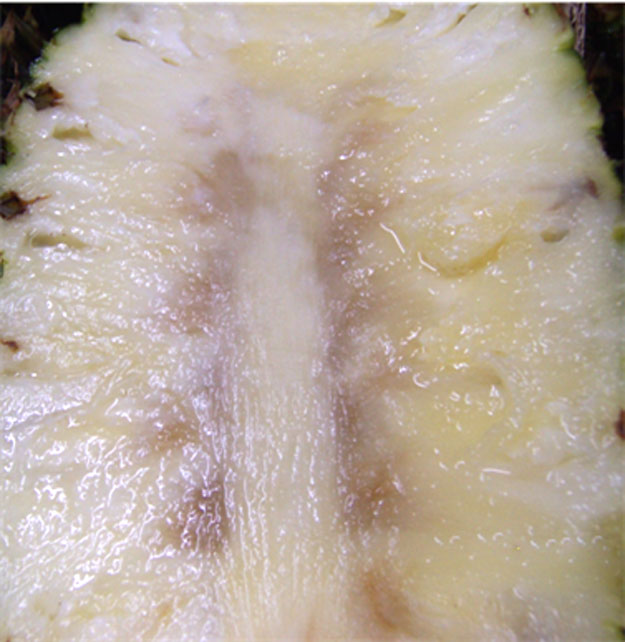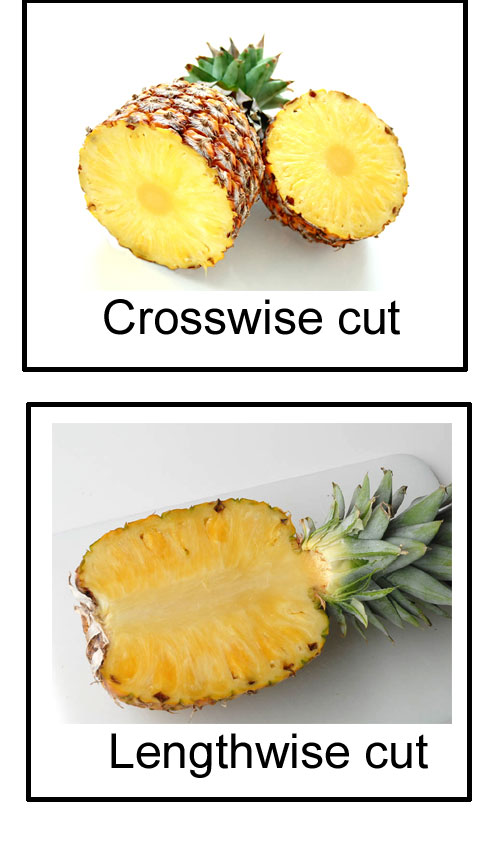As many of you know by know, I am always quick to point out ways the USDA could improve their inspection procedures and clear up and misconceptions. Pineapples and internal breakdown could use some help. To begin with let’s first explain what internal breakdown is.

As seen above, you can clearly see the discolored flesh of the cut pineapple. This is classic “Internal Breakdown.” Unfortunately there are no external symptoms to give you a clue as to which pineapples may have internal discoloration, so you must cut random fruit. I would suggest you cut the pineapples showing the most yellow color first, or in the firm or ripe stage. The USDA inspection instructions direct their inspectors to cut the fruit lengthwise, to allow them to seem the most exposed surface area.

But if you have ever witnessed a USDA inspector cutting pineapples you may find them cutting the fruit crosswise. Are they wrong? Well technically, yes. But if you use common sense all experienced inspectors know that the internal breakdown is usually found towards the base. The following comes from USDA’s own inspection instructions: “Firm, light brown water soaking of the flesh appears first in the base of the fruitlets near their attachment to the core region an inch or two above the base of the fruit. As it advances, the discoloration tends to move outward and upward until it involves most of the fruit. In most cases there is no external indication of the defect.” So if they cut the fruit lengthwise may they miss the discolored area near the base? Maybe.
But the cutting guidelines are not the only thing the USDA should clarify. The U.S. Standard could use some help too.
I will take this step by step:
1) For U.S. No. 1, all pineapples must be free from Internal Breakdown. (Free from means present in any amount. There is no area allowed before scoring a free from defect as a defect. If you can identify the defect, and the standard states it is “free from” them the specimen is scored as a defect, regardless of the area affected. For example, decay is a free from defect. If you have a area of decay 1/32 inch in diameter, or 2 inches in diameter, both spots are scored as decay, as decay is a free from, present in any degree, defect.)
2) If you look up the definition for Internal Breakdown in the U.S. Standard it states: “Internal breakdown” means a physiological deterioration which results in a watersoaked or brown or blackish discoloration. The key words are “watersoaked or brown or blackish discoloration, meaning if you cut the pineapple and see a brown discoloration (as see above), then you have found Internal Breakdown. Also, according to the definition if you cut the pineapple and you see only a watersoaked discoloration then you have found Internal Breakdown. In other words the Internal Breakdown does not need to show brown or black, only if it is at least watersoaked.
3) If you look further in the U.S. Standard the craziness begins. Under the Classification of Defects, under the Damage by Internal Breakdown, it now states: “When more than 10 percent of the edible flesh has a light to medium brown discoloration which materially detracts from the appearance or edible quality of the fruit.” As you can see, now the standard states there must be at least a light to medium brown discoloration present (not just being watersoaked) to score as Internal Breakdown. AND what happened to “Free From?” In this section of the standard it now states a specific area allowed for Internal Breakdown before it should be scored a defect.
So what should you do? Feel free to cut the pineapples anyway you feel will give you the best chance to detect Internal Breakdown. Personally, I cut the pineapples crosswise, near the base. Is Internal Breakdown a free from defect or not? Since the standard does state a specific scoring guideline I would use the guideline, that at least 10% of the edible flesh be affected before scoring as a defect. Now does Internal Breakdown have to be at least light brown in color? I guess if you say that watersoaked flesh is the same as being light brown in color, then I think we are talking about the same thing. Until the USDA develops a visual aid depicting what should be considered as being watersoaked, or light brown, then feel free to use your judgement when scoring this defect.

2 Comments on “Pineapples- Internal Breakdown”
There is a lot of information regarding the internal breakdown on The Pineapple Botany, Production and Uses by D.P.Bartholomew. There is also the the Global Gap / Euregap procedures that tell us what to look for translucency levels and iternal breakdown. Also uner this link there is valuable information: Optimizing Postharvest Handling and Maintaining Quality of Fresh Pineapples (IICA.
The cross cut and or the length cut only gives you an indication of maturity of the fruit. There are also Charts that Del Monte and or Dole uses, but gives an misinterpretation to the consumers and the USDA inspectors have not been trained to actually be able to make an proper quality assesment to the internal condition of the fruit.
Pretty! This was a really wonderful article. Many thanks for providing these details.